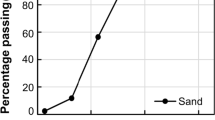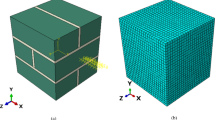Abstract
Based on the measured properties of individual bricks, blocks and mortar specimens, composite model expressions are presented for elasticity, creep and moisture movement of masonry in two directions. The model demonstrates the influence of creep in horizontal moisture movement, and allows for anisotropy of brick or block. Simulation of the role of moisture diffusion in masonry is a requirement for statisfactory predictions by the model, this being achieved by testing specimens having the same volume/exposed surface area ratio as the masonry component phases. Experimental verification is shown for clay brickwork walls and piers, and for calcium silicate walls.
Résumé
On exprime des valeurs d’élasticité, de fluage et de mouvement d’humidité dans deux directions au moyen d’un modèle composite de maçonnerie réalisé d’après les propriétés mesurées de briques individuelles, de blocs et d’échantillons de mortier. Le modèle démontre l’influence du fluage sur les mouvements horizontaux d’humidité, et tient compte de l’anisotropie de la brique ou du bloc.
Comme le modèle ne peut donner de résultats satisfaisants que s’il inclut une simulation du rôle de la diffusion d’eau dans la maçonnerie, on effectue des essais sur des spécimens qui présentent le même rapport volume/surface exposée que les phases en présence dans la maçonnerie. On procède à une vérification expérimentale pour des murs et jetées en briques et pour des parois en briques silico-calcaires.
Similar content being viewed by others
References
Alexander, S. J. and Lawson, R. M., “Design for movement in buildings’, CIRIA Technical Note 107 (Construction Industry Research and Information Association, 1981).
BS 5628: Part 2, ‘Structural Use of Reinforced and Prestressed Masonry’ (British Standards Institution, 1985).
DIN 1053, ‘Masonry design and construction, Part II’ (Deutsches Institut für Normung, 1985).
Working Documents for TC 179 (Masonry) (International Standardization Organisation, 1987).
Lenczner, D., ‘Brickwork: guide to creep’, SCP 17 (Structural Clay Products Ltd, Newcastle, Staffordshire, UK, 1980).
Schubert, P., ‘Deformation of masonry due to shrinkage and creep’, in Proceedings of 5th International Brick Masonry Conference, Carleton University, Ottawa, 1980, pp. 303–316.
Brooks, J. J., ‘Time-dependent behaviour of calcium silicate and Fletton clay brickwork walls’,Proc. Br. Masonry Soc. 1 (1986) 17–19.
CEB-FIP, ‘International recommendations for the design and construction of concrete structures’, in Comité Européen du Béton—Fédération Internationale de la Précontrainte, FIP 6th Congress, Prague, 1970.
Idem, ‘Model code for concrete structures’ (Comité Euro-International du Béton—Fédération Internationale de la Précontrainte, Paris, 1978).
ACI Committee 209R-82, ‘Prediction of creep, shrinkage and temperature effects in concrete structures’, in ‘ACI Manual of Concrete Practice, Part 1: Material and General Properties of Concreteŕs (ACI, 1984).
Bazant, Z. P. and Panula, L., ‘Practical predictions of time-dependent deformations of concrete: Part 1— shrinkage’,Mater. Struct. 11 (65) (1978), 301–316.
Idem,, ‘Practical predictions of time-dependent deformations of concrete: Part 2—basic creep’,ibid. 11 (65) (1978) 317–328.
Idem,, ‘Practical predictions of time-dependent deformations of concrete: Part 3—Drying creep’,ibid. 11 (66) (1978) 415–424.
Idem, Bazant, Z. P. and Panula, L. ‘Practical predictions of time-dependent deformations of concrete: Part 4—temperature effect on basic creep’,ibid. Mater. Struct. 11 (66) 424–434.
Idem,, ‘Practical predictions of time-dependent deformations of concrete: Part 5—cyclic creep, non-linearity and statistical scatter,ibid. 12 (1979) 169–183.
BS 8110: Part 2, ‘Structural use of concrete: Code of Practice for special circumstances’ (British Standards Institution, 1985).
Lenczner, D., ‘Creep in brickwork with and without damp proof course’,Proc. Br. Ceram. Soc. 21 (April 1973) 39–49.
Lenczner, D. and Salahuddin, J., ‘Creep and moisture movements in a brickwork wall’, Proceedings of 4th International Brick-Masonry Conference, Bruges, 1976.
Brooks, J. J. and Abdullah, C. S., ‘Geometry effect on creep and moisture movement of brickwork’,Masonry Internat. in press.
Hansen, T. C., ‘Creep of Concrete’, Bulletin No. 33 (Swedish Cement and Concrete Research Institute, Stockholm, 1958).
Idem,, ‘Thesis of multi-phase materials applied to concrete cement mortar and cement paste’, in International Conference on the Structure of Concrete (Cement and Concrete Association, London, 1968) pp. 16–23.
Hansen, T. C. and Nielson, K. E. C., ‘Influence of aggregate properties on concrete shrinkage’,ACI J. 62 (1965) 783–794.
Hirsch, T. J., ‘Modulus of elasticity of concrete as affected by elastic moduli of cement paste matrix and aggregate’,ibid.,59 (1962) 427–451.
Kameswara Rao, C. V. S., Swamy, R. N. and Mangat, P. S., ‘Mechanical behaviour of concrete as a composite material’,Mater. Struct. 7 (40) (1974) 265–270.
Hobbs, D. W., ‘The dependence of the bulk modulus, Young’s modulus, creep, shrinkage and thermal expansion of concrete upon aggregate volume concentration’,ibid. 4 (20) (1971) 107–14.
Counto, U. J., ‘The effect of the elastic modulus of the aggregate on the elastic modulus, creep and creep recovery of concrete’,Mag. Concr. Res. 16 (48) (1964) 129–138.
Ameny, P., Jessop, E. L. and Loov, R. E., ‘Strength, elastic and creep properties of concrete masonry’,Int. J. Masonry Constr. 1 (1) (1980) 33–39.
Shrive, N. G. and England, G. L., ‘Elastic creep and shrinkage behaviour of masonry’,ibid. 1 (3) (1981) 103–109.
Ameny, P., Loov, R. E. and Shrive, N. G., ‘Models for long-term deformation of brickwork’,Masonry Internat. 1 (1984) 27–36.
Brooks, J. J., ‘Composite Modelling of Elasticity and Creep of Masonry’, Report (Department of Civil Engineering, University of Leeds, 1987).
Idem, Brooks, J. J., ‘Composite Modelling of Moisture Movement and Thermal Movement of Masonry’, Report (Department of Civil Engineering Report, University of Leeds, 1987).
Brooks, J. J., ‘Composite models for predicting elastic and long-term movements in brickwork walls’,Proc. Br. Masonry Soc. 1 (1986) 20–23.
Brooks, J. J. and Abdullah, C. S., ‘Composite model prediction of the geometry effect on creep and shrinkage of clay brickwork’, in Proceedings of 8th International Brick/Block Masonry Conference, Dublin, Vol. 1 (Elsevier Applied Science, 1988) pp. 316–323.
Author information
Authors and Affiliations
Rights and permissions
About this article
Cite this article
Brooks, J.J. Composite modelling of masonry deformation. Materials and Structures 23, 241–251 (1990). https://doi.org/10.1007/BF02472197
Issue Date:
DOI: https://doi.org/10.1007/BF02472197




